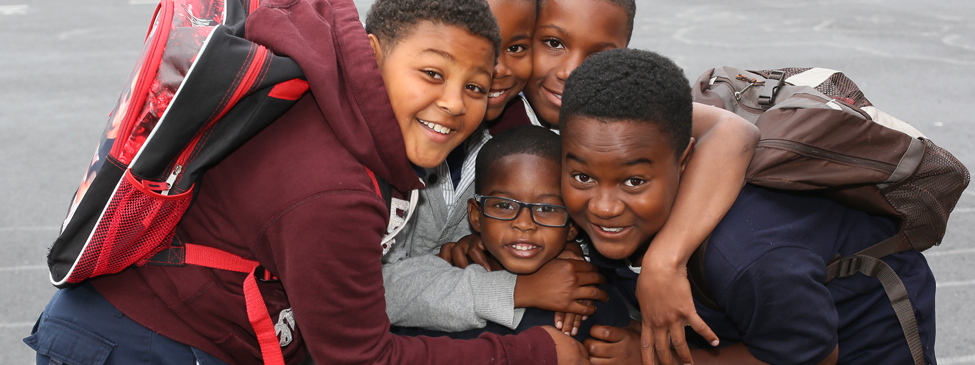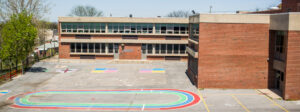Chris Chatmon is a former teacher, youth development professional, and the Deputy Chief of the Office of Equity in the Oakland Unified School District (OUSD). In 2010, Chris was tapped to direct the Office of African American Male Achievement (AAMA) and create programs, curricula, courses, and spaces to specifically address the needs of underserved African American male students in OUSD. In the six years since, AAMA has garnered national attention for its unique methods to empower young African American men, steer them away from the criminal justice system, and drive results in the classroom. We sat down with Chris to learn more about AAMA and the keys to its success.
What inspired you to re-imagine education for young men of color?
Going to public school in San Francisco, teachers didn't understand me. In elementary school, I would move and be excited like a normal kid, and they’d paddle me. In third grade, my desk was in the coat closet and I was suspended. In middle school, I got banned from public school busing and was put in remedial classes. In high school, my guidance counselor said, “You're not going to graduate. You don't have what it takes to go to college.”
It’s a classic story—an experience many black children go through. My saving grace was boys clubs, neighborhood parks, and my community recreation center. I came to these places with my head down and somebody always picked me up. My junior year in high school I made the basketball team and began to understand how to navigate the public school system. I made a commitment to graduate and come back and be an extraordinary teacher and transform the lives of all children that came into my classroom.
It was really through the journey of teaching and later, leading non-profits and working in youth development, that I saw I had a gift to organize people around a common cause: the service of children. AAMA gave me the opportunity to leverage my years of teaching, being a school leader, working in group homes and residential treatment, and my role as a father of three boys in the public school system and be intentional and unapologetic around the needs of African American male children. It was the perfect alignment of my passion, my purpose, and my profession.
When you started as Director of African American Male Achievement, what were your goals?
The goals were to eliminate the achievement gap, increase graduation rates, improve grade level literacy, and reduce suspension and incarceration rates. We thought, if we get African American male students to feel engaged and loved, and have a vibrant, culturally relevant curriculum and safe space where they can manifest their hopes, dreams, and aspirations, they won’t drop out of school and they’ll be less likely to get caught up in the justice system.
The re-frame was really around getting school culture right. The way we actually get at reducing suspension and incarceration rates is through strong school culture and engaged instruction. In the last six years, this approach has led to us graduating 20 percent more students and suspending 47 percent less.
The fact that we've called out these goals for young black boys, and that we’ve been able to stay in the work in a system that is constantly changing and evolving, is huge. We’re at a point where people are looking at the conditions, the culture, the structure, and the systems we created that push out black and brown boys, and now it's okay to talk about it from a systemic standpoint. More folks at our school sites—teachers, students, families, and principals—have been able to take on our best practices, routines, and rituals to begin to change the educational outcomes of African American males.
Your Manhood Development Program has gained a lot of attention across the country. Where did the idea come from and how did you roll it out?
When we first launched AAMA in 2010, we embarked on a listening campaign and interviewed several hundred African American male students from kindergarten through twelfth grade. There were three things that came up 80 percent of the time in conversation with our Kings—we call all students “Kings” to empower them and allow them to see themselves as more than the prevailing stories the world paints for them. One, that in the first couple weeks of school, adults did not talk to them. Two, when adults did talk to them, they engaged them as if they’d done something wrong, or were bad. And three, in their school day, our Kings did not have access to African American males.
These responses reaffirmed the importance of having a true manhood development class for students—a class where an African American male teacher works with African American male students to unlock their cultural legacy and history, align their values, understand their innate greatness, have a safe space to discuss current events, and imagine what they want to be in life. That is the essence of the curriculum. The hope was that it would lead to an increase in attendance, a reduction in referrals and suspensions, and an improvement in grade point average.
Fast forward six years, the program has been nationally recognized and replicated from Indianapolis to Seattle to San Francisco. The class spoke immediately and directly to what black boys were saying about how they experienced school. The first semester we launched, we immediately got feedback that it was the one place during the school day that black boys could be their authentic selves, understand that their history didn't start in slavery, and access culturally informed language arts, mathematics, science, and history.
What kind of people do you recruit to be in front of Kings?
We hire for attitude and train for skill. We're looking for people who understand that African American children have innate greatness and are beautiful and brilliant. Our instructors have to love kids. You can feel those attitudinal and values-based aspects of a person upon meeting them: They either have it or they don't. I can teach the technical pieces in terms of instructional pedagogy, differentiation, and alternative ways to evaluate. What I can't teach, at least on our timeline, is how to love a child.
Unfortunately, too many teachers don't see our kids as assets, and the transformation needed to change that adult mindset is painstakingly slow. There's not enough professional development and professional development in school systems isn’t valued. The deep dive and time required to create an equitable classroom structure, where teachers see black, brown, and other marginalized children as geniuses, takes work. The heaviest lift for us is not the child. We can transform a child. The heaviest lift is changing adult behavior.
As you think about AAMA in the next six years, where do you want to take the program next?
I think going deeper and broader with the work. Definitely having more classes written from the African American perspective, and having not just black boys taking these classes, but all children taking these classes. I hope our success so far allows us to have larger numbers of teachers go through our professional learning communities, so they can begin to put into practice what we have known and held to be true.
But I would also like to see other districts supporting offices of African American Male Achievement, too, and being a thought partner, critical friend, or even a consultant to build capacity to the work we’re doing. I’d like to see targeted strategies for other groups of students: an African American girls strategy, a Latino targeted strategy, Asian and Pacific Islander. I would like our program to make it okay to have targeted strategies to accelerate the educational outcomes of a subgroup, but also to inform the broader system on what is our collective responsibility to get resources to children that need them in different ways.
What is your advice to other districts or school leaders who are interested in replicating this work?
Definitely engage the community. Continue to use data to substantiate why you need to do something differently. Not just quantitative data, but also qualitative data. I think if we're going to get to anything equitable, we've got to be able to understand each other’s stories and create enough safe spaces where we can lead with those stories. I think that's where we begin to find intersectionality and see our own common humanity.
Don’t talk about it, do it. There's folks who started the conversation with us six years ago who are still just talking. They still have the same despaired outcomes. While we may not have mastered anything, six years down the road we are seeing results.
I would push folks to have the audacity to do something other than what they’re presently doing. Even if you can't see what’s below, take that leap of faith to do something for students who historically we have not done enough for.





